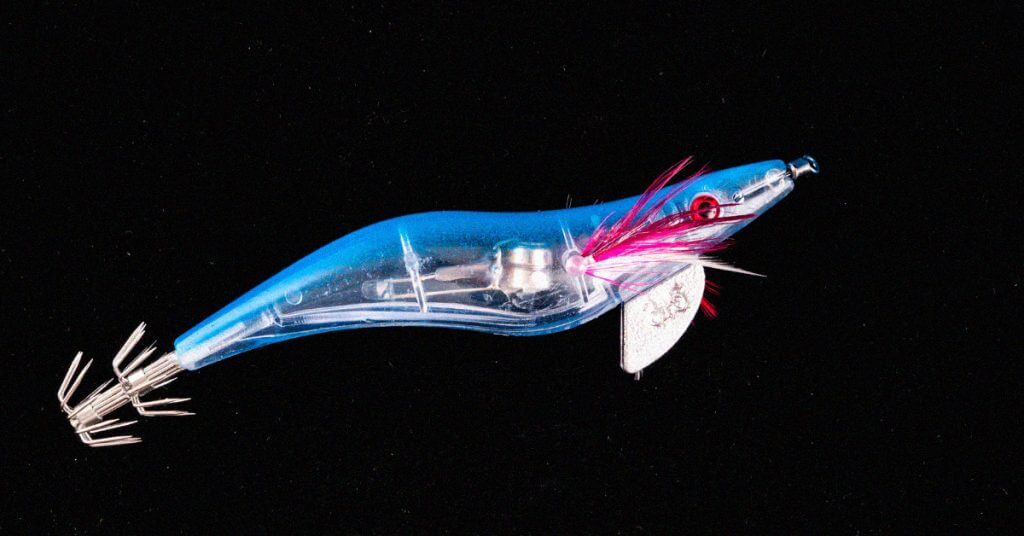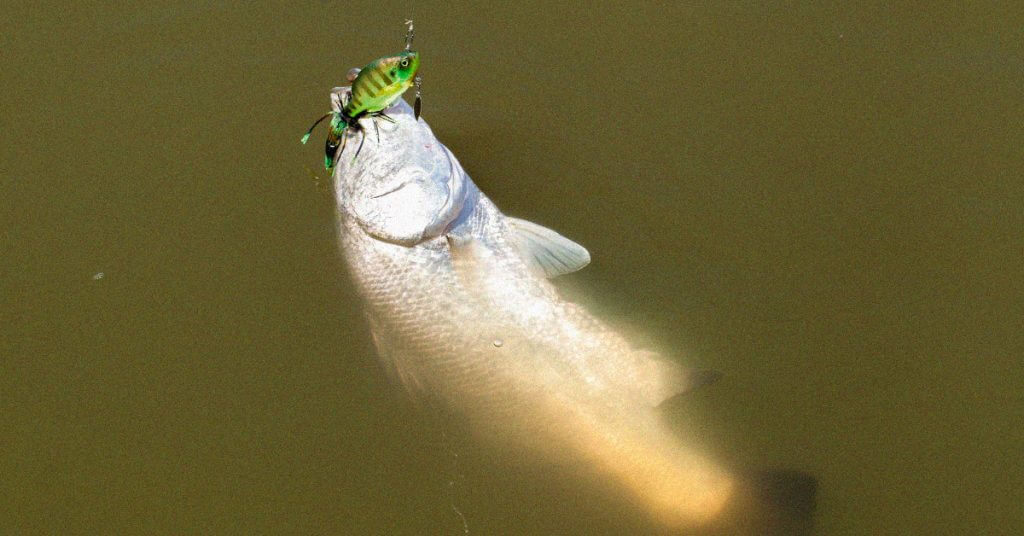Creature baits for bass go together like me at “all you can eat” seafood buffets. It’s a match made in heaven and one that has been battle tested unlike any other matchup.
What makes creature baits one of the best choices for bass is the sheer variety of options and versatility to use them in almost any scenario.
If you have enough creature baits in your tackle box, it’s not likely that you really need anything else.
I hope this guide helps you understand what these baits really are, how to use them properly, and how to maximize on the little things that make each lures presentation unique. Let’s get into it.
What are Creature Baits?
It all started with soft plastic baits that resembled the worm. With these worms emerging as one of the most successful lures for fishing, manufacturers decided to develop baits of other shapes.
As plastic molding technology improved with time, the design of creature baits has evolved significantly.
In theory, the creature baits are supposed to resemble crawfish and baitfish in appearance and action. But in reality, they do not always mimic the natural forage of the bass.
Most of these baits come with a combo design and don’t fall under the category of lizards, crawfish, or crawdad.
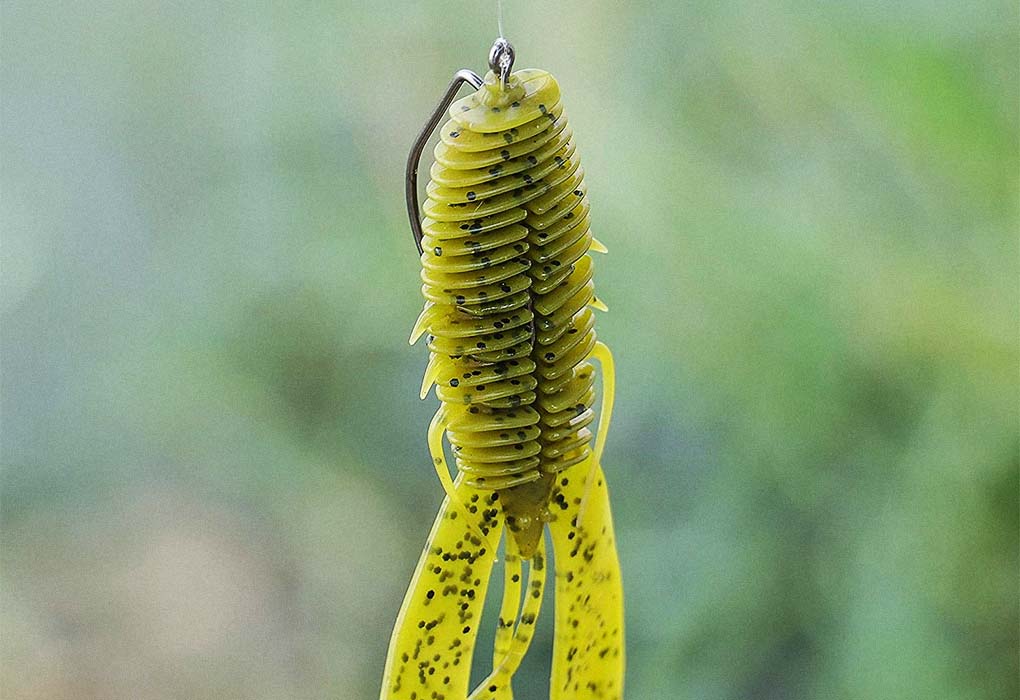
Fact is, creature baits look more like unearthly mutants with their flashy colors and appendages or legs. Even so, once these baits hit the water, they have enough visual appeal and natural action to tempt the bass.
Creature bass baits vary in shape and size. They can be anywhere between 3 to 6 inches in length and can generate different actions based on their shape.
This makes them easily noticeable to the bass, who can’t resist the urge to nibble.
Most creature baits also have a streamlined design that makes them a great choice for using in heavy covers, thick vegetation, or flooded bushes.
Since the idea is to attract the bass, some of these baits are designed to vibrate and displace a lot of water.
However, there’s another theory as well. Some of these soft plastic creature baits are designed to look like a threat to the bass. So instead of considering it as food, they attempt to attack it.
What Color Creature Baits Work Best?
Creature bass baits come in a wide combination of colors. In my experience, some colors are more effective for bass fishing than others. The primary factor on which the color choice depends is the water clarity.
It’s best to use brightly colored fishing lures in dark or muddy ponds. This improves the bait’s visibility for the bass. When the water is clear, softer colors are the better choice.
I have found bolder colors like red, orange, and yellow ideal when the visibility is limited. Creatures with two-color combos can also be effective when you are fishing in dingy waters under an overcast sky.
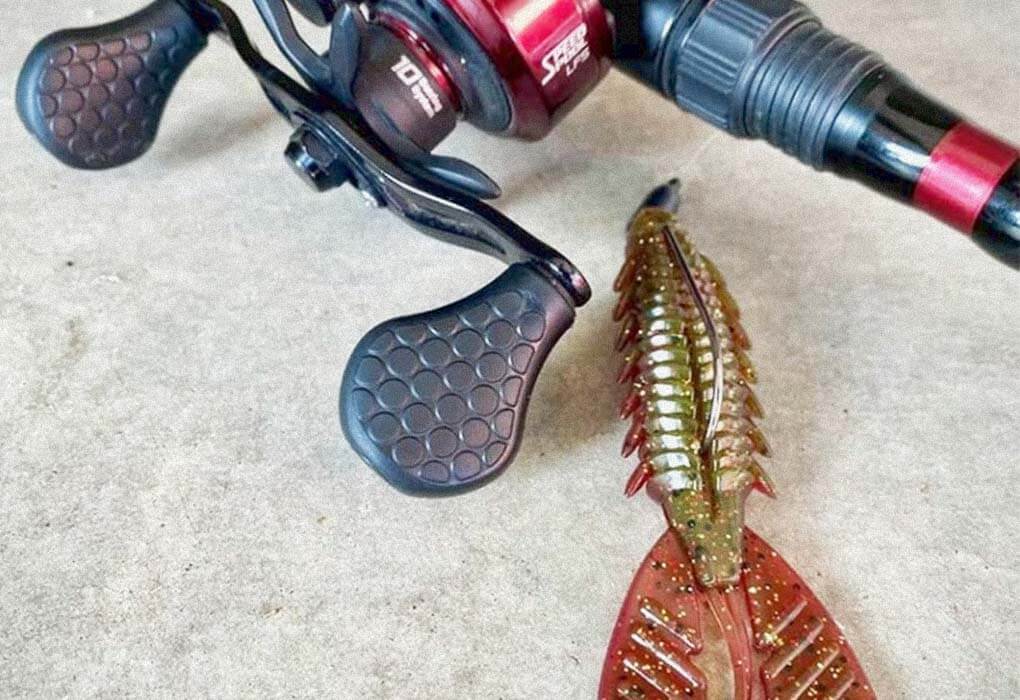
The low light conditions will further reduce underwater visibility. In fact, the sunlight reflects off the bait fish like shad, and shiners and makes them more visible. So using iridescent coloration can help on a cloudy day.
When visibility is clear, white, green pumpkin, watermelon, or translucent baits are more effective. Quite simply, the bass is not dumb. If you use a flashy bait in clear water on a bright sunny day, it will simply put off the fish.
One more factor when choosing bait color is the time of the year. For example, when the bass is chasing shad in fall, picking a shad-colored bait is the right pick.
Note, the consideration isn’t the same during night fishing. Most pro anglers choose black or dark green or dark blue lures during darkness.
The reason is, at night, the water surface presents a lighter background. So darker colors help in outlining the bait and allow the bass to strike more accurately.
Best Techniques for Fishing Creature Baits for Bass
Since bass can be found in a variety of depths, techniques of presenting your bait need to be different. Here are two of the bass fishing techniques that I have found most effective with creature bass baits.
Flipping and Pitching
When largemouth bass is lurking around a shallow heavy cover, flipping and pitching are the two most effective ways of presenting creature baits.
They can be used in open waters and also around submerged rocks or grasses that present a great opportunity to catch big bass.
While these techniques are similar, there is a difference in the action. Also, you don’t need to reel up between the casts while flipping.
Since these techniques are meant for big bass, you need to use a longer rod with fast action. For flipping, rods over 7 feet will give you more control. For pitching a slightly shorter rod, around 7 feet, is ideal.
Along with that, you need a high-speed reel and a heavy-duty braided line. Also, use a heavy hook that’s strong enough to handle the big bass.
While flipping you use the swing of the rod and the momentum of the creature bait to place it in the target zone. In addition, you can increase the distance by pulling out some excess line from the reel with your free hand.
Pitching is used for targets that are further away. In this case, you need to hold the bait and the extra line in your free hand and point the end of the rod towards the target area.
Then let go of the bait and allow the line to go out from the spool.
Once the bait hits the water, stop the spool. The harder the pitch, the further the bait will travel.
Pitching requires more accuracy, so you need to practice more. That way, you will be able to use the weight of the lure to carry the bait to the right spot.
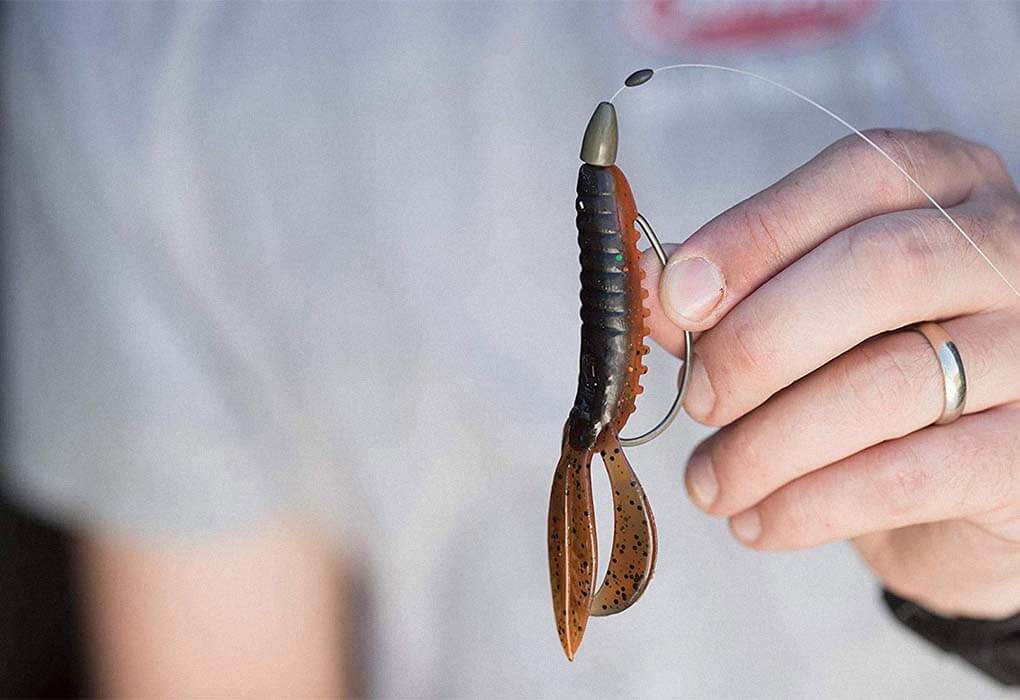
Jigging
Jigging is a versatile method that can be used in both clear and murky water. I’ve used jigs successfully in shallow conditions and also in deeper waters. The trick is to choose the right jig head to match the conditions.
A jig comes with skirts or hairs that combine with a creature bait to create a unique action. Anglers also use retrieval methods like crawling or stroking to get the most bites.
There are multiple varieties of jigs you can use including the casting jig, flipping jigs, or the football head jig. Casting jigs are good for heavy covers whereas football jigs work great over rocky bottoms.
Flipping jigs are the hardiest ones and are best for trophy bass.
You can use a casting or spinning rod for this technique. Ideally, pick a fast action rod that’s at least 6.5 to 7 feet in length. Flipping and pitching are the two primary methods for casting a jig.
I’d say that jigging is more about feeling the vibrations and sensing a bite. When I started out, it took me some time to identify a bass bite from the jig bumping against underwater rocks. For that, practice is the key.
How to Rig Creature Baits?
A big advantage of soft plastic creature baits is they can be rigged in multiple ways.
Carolina Rig
In my experience, using a creature bait with a Carolina rig is one of the best presentations for bass fishing. The rig is perfect for allowing full movement of the bait and works for depths between 15 to 40 feet.
Since the rate of fall of the heavier creature baits is slow, they stay in the strike zone for longer periods. Combining tungsten weights with a Carolina rig is a great way to feel the subtle bites.
However, when you’re fishing in tight spots, the Carolina rig isn’t the best choice.
Texas Rig
Since the Texas rig is weedless, it can be used effectively with a creature bait around heavy covers. Besides, it’s super simple to set up and works great with all fishing tips.
Just slip on the bullet weight, tie the hook, and attach the bait to it. While fishing in heavy covers, you can also “peg the hook” to fix the weight to the top of the hook. This makes the rig more compact.
I have also seen anglers using glass beads along with Texas rigged creature baits in muddy water. The beads collide with the weight and create a sound that attracts the bass.
Dropshot Rig
The dropshot rig is one of the most versatile finesse rigs you can use in a wide variety of conditions. Basically, it is a saltwater fishing technique that got channeled into bass fishing.
Here the weight is kept at the bottom of the line and the hook and the bait are placed above it. Since the bait remains suspended above the bottom. This places it in the strike zone, especially when the water is cold and bass are sticking to the bottom.
While using the dropshot rig, make sure that the sinker sticks to the bottom. With the right amount of bottom contact, the rig works great for finicky bass. That said, I’d prefer not to use the dropshot rig in heavy covers.
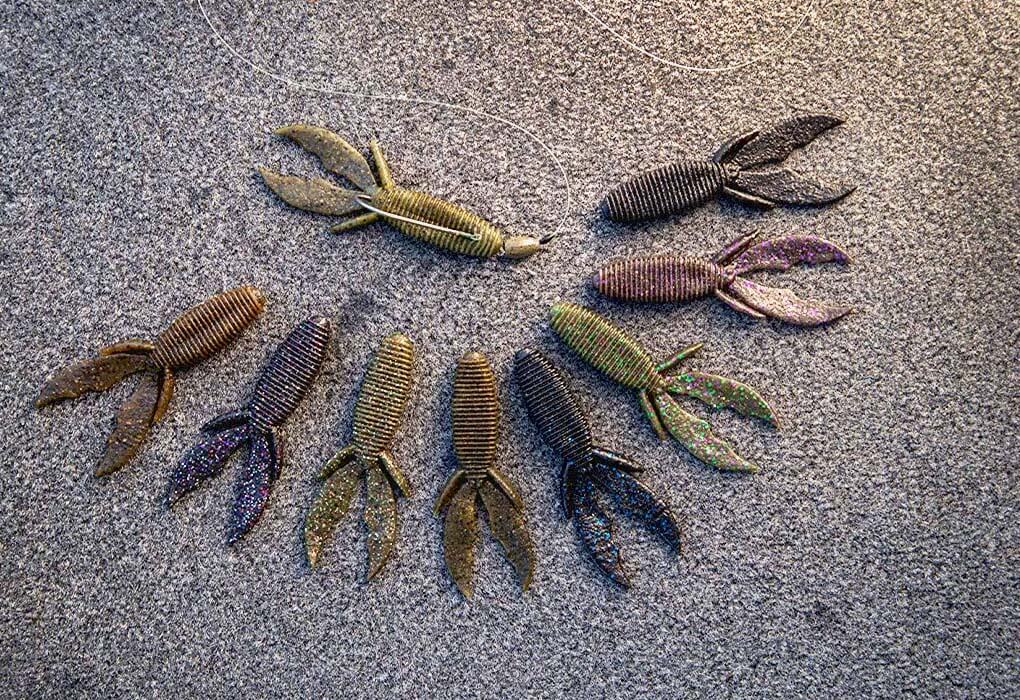
5 Best Creature Baits
Here are the 5 best creature baits for bass that I have found effective.
Berkley PowerBait MaxScent
This bait is a popular choice that comes in multiple colors and works great with Carolina or Texas rigs. Apart from a realistic texture and great action, it also has a powerful scent field to attract bass.
Gary Yamamoto Cowboy
The J-shaped legs of this soft plastic lure deliver a great kicking action that combines well with the flipping appendages.
The streamlined profile also makes it a good choice when you’re looking for big bass in dense vegetation.
Strike King KVD Rodent Bait
This is the best creature bait that combines a compact craw-type shape with large water displacement. In addition, it’s enhanced with actual coffee bean granules to hide human smells and attract the bass.
Zoom Bait Baby Brush Hog
This range of Zoom Brush Hog creature baits is great for shallow waters with a lot of vegetation. I have found some of the colors ideal for low-light conditions.
As a bonus, it comes with the salt mixture we know and love about Zoom creature baits.
Missile Baits D Stroyer
This 7-inch creature bait can be used with multiple rigs and works great for monster bass. With multiple appendages, the action is unique and it works in cover, as well as in open water conditions.
Moreover, the bait is super affordable.
Frequently Asked Questions
What scent attracts bass the most?
The most attractive scents for bass are salt and garlic. They increase the chances of getting a harder strike resulting in an easier hookset.
What is the best technique for using creature baits?
I think Flipping a Texas-Rigged creature bait near docks and brush piles is the best technique for catching big bass.
Final Thoughts
Since bass has the most diverse predatory instinct, choosing the right bait is critical. With the right creature baits for bass, you’ll have the perfect setup to improve your odds. And with so many options on the market, you can always get creative.
Best of all, creature baits are cheap compared to a lot of hard-bodied lures so you don’t have to stress if you lose some or if you buy one that simply doesn’t work. Get out on the water and give them a shot.
Good luck out there!


